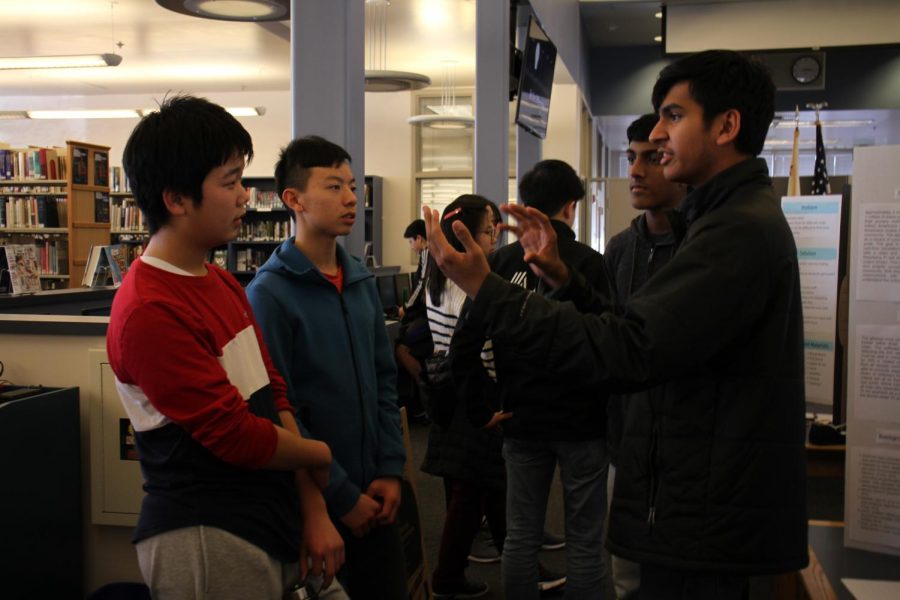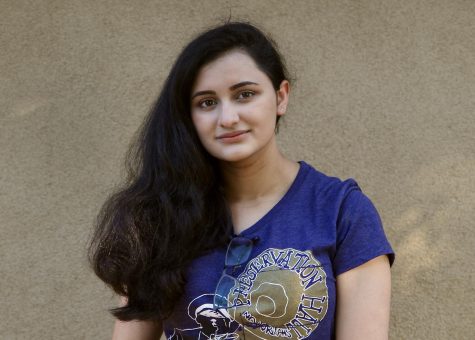STEM students present inspiring research
March 29, 2019
As students, staff and parents made their way through the bustling library, Lynbrook’s young scientists gestured to their trifolds, hoping to stand out in a room filled with big ideas. At the STEM Expo on March 8, students showcased their original research and engineering projects and presented to their peers in preparation for the Synopsys Science Fair.
Attendees were greeted at the front of the library by STEM class adviser Isaac Pallone and chemistry teacher Lester Leung, who handed them short feedback forms and asked them to evaluate students’ presentations as they walked around the room. Around 200 people were in attendance, including Lynbrook students and teachers, parents and community members from technology companies in the area, up from about 130 last year.
The number of Expo participants also increased significantly. In the past, only students of the Independent Study in STEM course have been required to present at the Expo; a new rule introduced this year mandated that all Synopsys entrants showcase their projects. This includes students who completed their projects outside of class, usually upperclassmen or returning Synopsys competitors.
“Since the turnout was good for both the audience and the presenters, I think that the students got greater variety in terms of feedback so they could improve their projects,” Pallone said. “And they also get an idea of the different projects that are out there.”
Held a week before the Synopsys competition, the STEM Expo was intended to help students prepare their presentations. By giving them a chance to discuss their projects and observe other students’ posters and presentation styles, the Expo helps competitors identify areas for personal improvement. The large volume and diversity of attendees also allowed students to gather a wide variety of feedback, particularly from parents and teachers.
“The parents were more likely to give feedback,” said junior Kavish Trivedi. “Though they’re not necessarily experienced in our respective fields, they usually have very useful professional experience when it comes to presentation skills and how to communicate your work.”
With the attendees’ commentary and a week to improve before Synopsys, competitors got to work on improving their presentations and modifying their posters. The completed feedback forms were distributed to the students, who considered the evaluations and made decisions about what to change. By the following Thursday, the day of Synopsys, the change was noticeable.
“I find that there’s a real difference in how comfortable they are with giving their presentation,” Pallone said. “At the Expo, they work on engaging the audience, creating their talking points and establishing the balance between speakers. By the time the science fair comes around, they have a polished poster, and they’re ready to present to the judges because they’ve had practice.”
The experience was not only enlightening to competitors, however. Many students, parents and community members who visited the projects learned something new at the Expo.
“The fact that [students] took time out of their routine to do something so unique was inspiring,” said Aditi Chockalingam, a sophomore who visited the Expo. “Some people have been working on their projects for three years. It took a lot of time and effort.”
The Synopsys winners have not yet been announced, but Pallone and Leung are confident that their students awed the judges with their hard work and refined presentations.
“Lynbrook had a great showing this year,” Pallone said. “We’ll have a lot of winners.”
Like Synopsys, the STEM Expo instilled in attendees a sense of admiration for aspiring student researchers, an appreciation of their effort and a feeling of wonder about the sciences. Many left with the thought that even high school students can make discoveries that shape the future.




































































Brian Clair • Oct 9, 2020 at 11:49 pm
The Science Museum I’ve heard about stem lecture from one of my acquaintances. This lecture is literally a lifetime opportunity for Science & Maths Students as it offers them to experience real science.